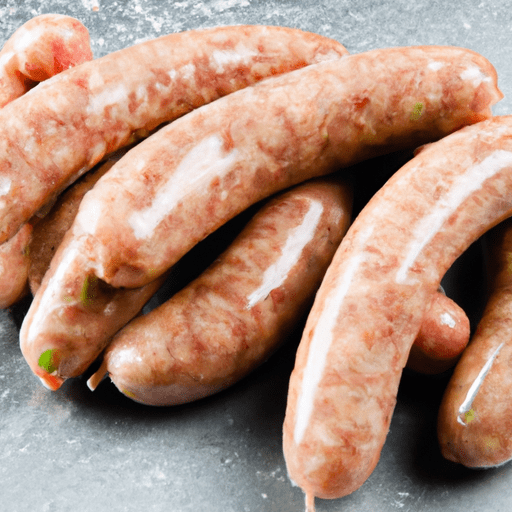Chipolata Sausage: A Delightful Addition to Your Culinary Repertoire
If you’re a fan of sausages, there’s one variety that you simply can’t ignore – chipolata sausage. With its tantalizing taste, versatile nature, and rich history, chipolata sausage has earned a well-deserved spot in the hearts and kitchens of food enthusiasts. In this blog post, we’ll delve into the world of chipolatas, exploring their mouthwatering flavors, commonly used cooking techniques, nutritional value, and some interesting historical facts that make them an irresistible choice for any food lover.
Taste that Delights the Palate
Chipolata sausage is a delicately flavored sausage that originates from France. Made using a mixture of ground pork, breadcrumbs, and seasonings, these sausages have a subtly sweet and savory taste that will leave you wanting more. The herbs and spices used in chipolata sausage often include parsley, thyme, nutmeg, and black pepper, adding depth and complexity to their flavor profile.
Versatile in the Kitchen
Due to their versatile nature, chipolatas offer endless possibilities in the kitchen. They can be enjoyed in a variety of ways, making them a true culinary chameleon. Chipolatas are commonly used in dishes such as stews, casseroles, breakfast plates, and even on the grill. They make a fantastic addition to pasta dishes or can be wrapped in bacon for an indulgent twist. The smaller size of chipolatas lends itself well to appetizers, snacking, and even charcuterie boards, where they can be served alongside other meats and cheeses. No matter how you choose to prepare them, chipolata sausages are guaranteed to elevate any dish they’re added to.
Nutritional Value of Chipolata Sausage
Chipolata sausage is a great source of protein, essential for muscle growth, repair, and overall health. However, it’s important to note that as with many sausages, chipolatas can contain high levels of fat and sodium. When incorporating chipolatas into your diet, it’s best to enjoy them in moderation and balance them with other nutritious ingredients such as vegetables, whole grains, and legumes.
A Rich History and Intriguing Facts
Chipolata sausage has a fascinating history that dates back to the 19th century in France. The term “chipolata” is derived from the Italian word “cipollata,” which means “made with onions.” Traditionally, chipolatas were made with finely chopped onions, which not only added flavor but also helped to keep the sausages moist during cooking.
In the United Kingdom, chipolatas have become synonymous with Christmas feasts, where they are a staple ingredient in the traditional “pigs in blankets” dish. These small sausages are wrapped in streaky bacon and roasted until golden and delicious, adding a burst of flavor to the festive spread.
In Conclusion
Chipolata sausage is a culinary gem that offers both flavor and versatility. Whether it’s a hearty stew, a sizzling breakfast plate, or a festive feast, chipolatas elevate any dish they grace. So why not give them a try and experience the delight of this delicious sausage for yourself? Incorporate them into your cooking repertoire and get creative in the kitchen – the possibilities are endless.
Chipolata Sausage
Origin: Chipolata sausage is believed to have originated in France. The word “chipolata” comes from the Italian word “cipolla,” which means onion. The sausage is thought to have been created in the mid-19th century in the region of France called Alsace.
Common Uses: Chipolata sausages are versatile and can be used in various dishes. They are commonly used in English cuisine, especially during festive meals like Christmas and Easter. They are often enjoyed as part of a traditional English breakfast. Chipolatas can also be used in stews, casseroles, or enjoyed grilled or pan-fried.
Nutritional Benefits: The nutritional profile of chipolata sausage can vary depending on the specific recipe and brand. However, generally speaking, they are a source of protein, vitamins, and minerals. They can also be high in saturated fat and sodium, so it’s important to consume them in moderation as part of a balanced diet.
Unique Properties and Historical Significance: Chipolata sausages are distinct for their small size and thinness. They typically consist of pork seasoned with herbs and spices, such as sage, thyme, or parsley. In France, they are often served as part of a dish called “choucroute garnie,” which is a popular Alsatian specialty of sauerkraut cooked with various meats, including chipolata sausages.
Historically, chipolata sausages have been associated with festive occasions. In the UK, they have been a traditional component of Christmas meals since the late 19th century. They are often wrapped in bacon and served alongside roasted meats and vegetables. The combination of chipolatas and bacon is sometimes referred to as “pigs in blankets” in British culinary terminology.




Use the share button below if you liked it.
It makes me smile, when I see it.